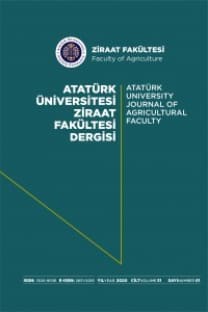Bazı serin mevsimbuğdaygil yem bitkilerinin Erzurum sulu ekolojik şartlarına adaptasyonu: I. yaş ve kuru ot verimleri
Erzurum sulu şartlarında 1995-99 yıllan arasında 7 serin mevsim buğdaygil yem bitkisi türüne (Agropyron cristatum, Dactylis glomerata, Peştuca arundinacea, F. pratensis, F. rubra, Lolium perenne ve Phleum pratense) ait 13 çeşidin yaş ve kuru ot verimleri, üç tekerrürlü olarak Şansa bağlı tam bloklar deneme deseninde kurulan tarla denemesinde araştırılmıştır. Çeşitlerin yaş ve kuru ot verimlerinde çok önemli şekilde farklı olduktan belirlenmiştir, f. arundinacea var. Apache, D. glomerata var. Modac ve F. arundinacea var. Hudson hem biçimlerde, hem de yıllık toplam olarak yaş ve kuru ot verimlerinde ilk sırayı almışlardır (sırasıyla 2374.9-807.6, 2103.9-676.5 ve 2059.4-728.1 kg/da'dır). D. glomerata var. Modac ve Tenderbite hem yaş, hem de kuru ot üretiminde daha yüksek verim ve daha dengeli bir mevsimsel dağılım göstermişlerdir. L. perenne'ye ait çeşitler de yaş ve kuru ot verimlerinde dengeli bir mevsimsel dağılış göstermişler, fakat verimleri tür ve çeşitlerin ortalaması altında kalmış ve düşük bulunmuştur. A. cristatum var. Fairway ve Phleum pratense var. Goliath hem yaş ot, hem de kuru ot verimlerinde ilk biçimde çok yüksek, fakat 2. ve 3. biçimlerde en düşük verim alınmıştır. F. rubra var. Monica ve D. glomerata var. Tenderbite hem biçimlerde, hem de yıllık toplam yaş ve kuru ot verimlerinde tür ve çeşitlerin ortalaması altında kalmış ve özellikle F. rubra var. Monica'nın verimi üçüncü biçimde çok düşük olup son sırayı almıştır. Araştırma sonuçlarına göre, Erzurum ve benzeri ekolojilerde sulu şartlarda yaş ve kuru ot üretimi için F. arundinacea var. Apache, D. glomerata var. Modac ve F. arundinacea var. Hudson çeşitlerinin, otlakiye amacıyla D. glomerata var. Modac çeşidinin kullanılabileceği sonucuna varılmıştır.
Adaptation of some cool season forage grasses To Erzurum ırrigated ecological conditions I. fresh and dry forage yields
The fresh and dry forage yields of the varieties of 7 cool season forage grass species (Agropyron cristatum, Dactylis glomerata, Peştuca arundinacea, P. pratensis, P. rubra, Lolium perenne and Phleum pratense) were evaluated through 1995-99 years in the irrigated condition in Erzurum Province. The trial Was conducted in the randomized complete block design with three replication. The varieties were very significantly different in fresh and dry forage yields. F. arundinacea var. Apache, F. arundinacea var. Hudson and D. glomerata var. Modac occupied the first order in both fresh and dry forage yields of cuttings and annual total production, respectively. D. glomerata var. Modac and Tenderbite gave higher yields in both fresh and dry forage and exhibited the balanced seasonal forage production by three cuttings. Although the varieties of L. perenne gave balanced seasonal forage production, but their yields were lower and under the average of the all varieties. A. cristatum var. Fairway and P. pratense var. Goliath were higher in both fresh and dry forage yields of the first cutting, but they gave the lowest yields in the second and third cuttings. F. rubra var. Monica and D. glomerata var. Tenderbite were under the average of all varieties in the fresh and dry forage yields of both the cuttings and annual total production, and especially the yields of F. rubra var. Monica in third cuttings were the lowest and had the last order in ranking. F. arundinacea var. Apache, F. arundinacea var. Hudson and D. glomerata var. Modac gave higher annual yields in fresh and dry forage by 2374.9-807.6, 2059.4-728.1 and 2103.9-676.5 kg/da, respectively. According to the trial results, F. arundinacea var. Apache, F. arundinacea var. Hudson and D. glomerata var. Modac were recommended for dry forage production, only D. glomerata var. Modac for grazing.
